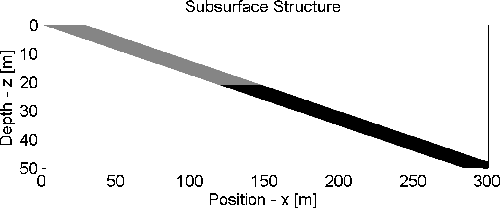|
|
|
|
Seismic investigation of natural coal fires: A pre-fieldwork synthetic feasibility study. |

|
|---|
|
Vmodel
Figure 1. Subsurface structure; a dipping, partially burned (grey) coal (black) layer. P and S wave velocities are given in Table 1. [NR] |
|
|
Figure 1 shows the layout of our 2D model space, with
layer properties shown in Table 1. A 5m thick layer of coal, half
burned, dips 10![]() across a background of sandstone. We synthesized a
seismic survey across the model with shots and receivers at 1-m
spacings. The source is a vertical force with the waveform of a
125-Hz Ricker wavelet. This is intended to simulate a
better-than-average sledgehammer
impact. The frequency of a real sledgehammer impact
is likely to be considerably lower and the waveform completely dependant on the local conditions. The receivers record both vertical,
across a background of sandstone. We synthesized a
seismic survey across the model with shots and receivers at 1-m
spacings. The source is a vertical force with the waveform of a
125-Hz Ricker wavelet. This is intended to simulate a
better-than-average sledgehammer
impact. The frequency of a real sledgehammer impact
is likely to be considerably lower and the waveform completely dependant on the local conditions. The receivers record both vertical, ![]() ,
and horizontal,
,
and horizontal, ![]() , (in-plane) components of particle velocity. In this report we focus on
the vertical (PP) component but include the horizontal component for
interested readers. The model neglects the major near-surface heterogeneity like soil layer, shale layers and fissures known to exist
at the site.
, (in-plane) components of particle velocity. In this report we focus on
the vertical (PP) component but include the horizontal component for
interested readers. The model neglects the major near-surface heterogeneity like soil layer, shale layers and fissures known to exist
at the site.
| Unit |
|
|
||
| Sandstone | 2000 | .2 | 1200 | .154 |
| Coal | 1200 | 0.0 | 800 | 0.0 |
| Ash | 300 | 0.0 | 200 | 0.0 |
|
|
|
|
Seismic investigation of natural coal fires: A pre-fieldwork synthetic feasibility study. |